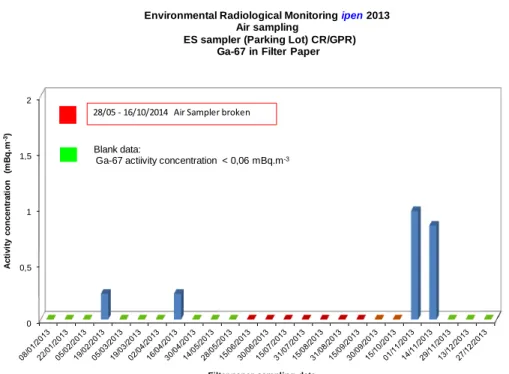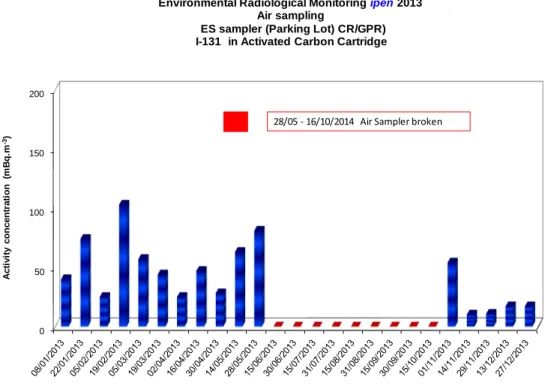BJRS
RADIATION SCIENCES
03-02 (2015) 01-10Assessment of the radiological control at the Ipen
radioisotope production facility
J. C. G. G. Carneiro¹, M. P. Sanches¹, D. L. Rodrigues¹, D. Campos¹, P. R.
Nogueira¹, S. R. Damatto¹, B. R. S. Pecequilo¹
1Instituto de Pesquisas Energéticas e Nucleares, IPEN–CNEN/SP
Av. Prof. Lineu Prestes, 2242 - Cidade Universitária – 05508-000 São Paulo – SP – Brasil
ABSTRACT
The main objective of this work is to evaluate the 2013 annual radiological control results in the radiopharmaceuticals areas of the Nuclear and Energy Research Institute, IPEN/SP, and the environmental radiological impact, resulting from the practices there performed. The current evaluation was performed through the analysis of the results obtained from occupational and environmental monitoring with air samplers and TL dosimeters. All monitoring results were compared with the limits established by national standards. The radionuclides detected by air sampling (in activated carbon cartridges and filter paper) at the workplace during radioisotope production were 131I, 99mTc and 99Mo, with activities concentrations values below the annual limits
values. For the radioactive gaseous releases (Bq/m3), the activities concentrations also remained below the
maximum admissible values, excepting to 125I release due to an unusual event occurred in a researcher laboratory,
but the radiological impact to environmental was no significant. The occupational monitoring assessment was confirmed by the Environmental Radiological Monitoring Program results with air samplers and TL dosimeters. The mean annual background radiation at IPEN in 2013, according to the Environmental Radiological Monitoring Program results was 1.06 mSv. y -1, below the ICRP 103 recommended limit of 20 mSv.y-1 for workers.
1. INTRODUCTION
The use of radioisotopes in medicine is one of the most important social applications of Nuclear Energy and IPEN (Nuclear and Energy Research Institute, São Paulo), is recognized as a national leader institution in research and development in the radiopharmaceutical area. Currently, more than 30 products available for medical uses are listed in the IPEN products and services catalogue. The production of IPEN Radiopharmaceuticals Center (CR) is divided in 3
different areas: Radioisotopes (99mTc generators and Primary Radioisotopes as 131I), Labelled
Compounds (131I and 18F) for diagnosis (PET and SPECT) and for therapy and Lyophilized Kits
for labelling with 99mTc. IPEN has a rigorous program of radiological control for the radiological
safety of IPEN workers and general public, through radiation protection programs in accordance with the national and international standards [1-4].
Radiological monitoring of a radioactive facility requires the use of various techniques for determining the radiological parameters, associated either to environmental contamination, surface contamination or radiation levels. In general, it is desired to use the monitoring techniques which have advantages in terms of time, cost or easiness of handling while, at the same time, are sensitive enough.
The main objective of radiological protection is to provide an adequate level of protection for the workers, general public and environment, so that the society exposures must be limited to risks considered acceptable. This study aims to evaluate the existing exposure situations in at radiopharmaceutical facility of IPEN/SP due to their practices. This work shows the radiological control techniques used at workplace and for the environmental monitoring, in order to estimate the resultant doses of the facility practices (Radioisotopes Production) and to compare the obtained results with the established values by the national standard [1,2,4].
1.1 Radiation Level Monitoring
According to the ICRP-103 Publication [3], a radiological control program with good success in any facility or operation should contain many parameters / indicators that are used to monitoring the workplace and reduce the radiation exposure.
The monitoring of air radioactivity is carried out to:
(a) Detect and quantify the radioactive material concentration in the air, (b) Limit and avoid the internal exposure,
(c) Provide a effectiveness indication of engineering controls and appropriate work practices to the prevention of dispersion and contamination and
(d) Support the choosing of the proper protective equipment.
The monitoring of workplace radiation level included the actions of general areas and areas
where there is the contact with potential radiation sources.
Discharges of radioactivity material in environment due the operations of a practice
The radiological air monitoring allows to estimate the potential dose received by the population due the inhalation. The air constitutes the primary pathway to transference of radioactive effluents to the environment.
2. METHODOLOGY
2.1 Area Monitoring to Detect External Radiation in the Workplace
The routine monitoring is done by monitors at the area subject to gamma radiation. A total of 18 points are continuously monitored by fixed detectors Geiger-Mueller and 11 points are
monitored by thermoluminescent dosimeters, TLD (CaSo4:Dy), located in select areas, with
2.2. Surface Monitoring
The surface contamination was assessed by indirect methods, using a smearing test followed by high-resolution gamma-ray spectrometry.
2.3 Air Monitoring - Indoor
The monitoring is done by air monitors using indirect methods and counting by high resolution gamma-ray spectrometry. These air samplers were located at workplace where there was probability of the air contamination occurrence.
2.4 Environment Radiological Control - Outdoor
The environment radiological control to the radiopharmaceutical facility is done as established in Environmental Radiological Monitoring Program of IPEN, PMRA 2013 [4-6].
The direct radiation in the environment was determined by measurements with TL dosimeters, with quarterly sampling.
To the determination of emitting gamma radionuclides were analyzed in filter paper and Activated Carbon Cartridge collected fortnightly of the air samplers localized at CR Parking Lot.
The measurement allowed the identification of short half-life radionuclides, as 67Ga (3.26 days)
and 131I (8 days) [4].
The gamma radionuclides emitters were determined by high resolution gamma-ray spectrometry.
3.
RESULTS 3.1 Area MonitoringThe results of area monitoring for external radiation, were carried out in 2013 with TL dosimeters, totalized 11 points. Of these, 5 points presented mean weekly values higher than the admissible maximum values of 400 µSv per week [1]. The higher dose rates were found out in points where is located the technetium-99m generator production and where there is an excess of packing, at CR Parking Lot, for posterior radioactive materials shipment.
Actions of radiological protection are adopted as: workers’ awareness to avoid these radiation exposure points, improvements of infrastructure, such as shielding, and avoiding the accumulation of radioactive material (packing) at the CR Parking Lot.
3.2 Air Monitoring
The detected radionuclides were 131I, 125I, 99mTc and 99Mo. The emissions of 131I and 99mTc were
resulted from leakages at the production cells. The 99Mo was detected in filter surface, indicating
particulate material. The activity concentration values (Bq/m3) of these radionuclides, except to
the 125I, are above than the admissible maximum values established by the national standard [1,
2] and summarized in Table 1.
An incident with 125I was detected in one of the research laboratories, which caused an air
contamination equivalent to 20 times of the maximum established value. The area was interdicted by the radioprotection team and after the implementation of radiological protection actions the place was released coming back to normality.
Table 1: Admissible maximum values of activity concentration [2]
Detected radionuclides Activity concentration (Bq/m3)
131I 757
99mTc 287356
99Mo 7575
3.3 Discharges of Radioactive Material in Environment due the Operations - Indoor
The detected radionuclides in the filter paper and Activated Carbon Cartridge of the chimneys from atmospheric liberations, it means, from discharges of gaseous radioactive effluents to
environment, due the practices of the radiopharmaceutical facility, were 123I, 131I e 18F. The
important contribution of 131I was observed in the total discharges, representing virtually the
totality of the atmospheric discharges. The mean annual value of activity concentration (Bq/m3)
for the 131I, obtained by chimneys’ filters analysis, was 1.76 Bq/m3. This value is below the
dispense level for gaseous waste of 3.7 Bq/m3, established by the standard CNEN NN 8.01 [7].
3.4 Discharges of Radioactive Material from Gaseous Effluents into Atmosphere Outdoor
3.4.1. Gamma spectrometry in filter paper
The activity concentrations of 67Ga in the filter paper determined by the air sampling are showed
in Fig. 1. The activity concentration values found out in the filter paper, for 2013, varied from
0.23 mBq/m3to 0.97 mBq/m3. The activity concentration values reported are bellow of the
0 0,5 1 1,5 2 A ct ivi ty co n cen tr at io n ( m B q .m -3)
Filter paper sampling date
Environmental Radiological Monitoring ipen2013 Air sampling
ES sampler (Parking Lot) CR/GPR) Ga-67 in Filter Paper
Blank data:
Ga-67 actiivity concentration < 0,06 mBq.m-3
28/05 - 16/10/2014 Air Sampler broken
Figure 1: Activity concentration of 67Ga in the filter paper of air sampler located at CR Parking Lot, IPEN, 2013.
The activities concentrations of 131I in filter paper determined by the air sampling are showed in
Fig. 2. The activity concentration values found out to the year of 2013 varied from 0.04 mBq/m3
to 0.07 mBq/m3. The values reported are bellow of the established limits by the national
0 0,05 0,1 0,15 0,2 A ct ivi ty C o n cen tr at io n ( m B q .m -3)
Filter paper sampling date
Environmental Radiological Monitoring ipen2013 Air sampling
ES sampler (Parking Lot) CR/GPR) I-131 in Filter Paper
Blank data:
I-131 activity concentration < 0,04 mBq.m-3
28/05 - 16/10/2014 Air Sampler broken
Figure 2. Activity concentration of 131I in the filter paper of air sampler located at CR Parking Lot, IPEN, 2013.
3.4.2. Gamma spectrometry in activated carbon cartridges
The activities concentrations of 131I in activated carbon cartridges determined by the air sampler
are showed in Fig. 3. The activity concentration found out to the year of 2013 varied from 10
mBq/m3 to 103 mBq/m3. The values reported are bellow of the established limits by the national
standard.
According to the standard CNEN NN 8.01 [7], for the elimination of radioactive gaseous waste,
0 50 100 150 200 A ct ivi ty co n cen tr at io n (m B q .m -3)
Cartridge sampling date
Environmental Radiological Monitoring ipen2013 Air sampling
ES sampler (Parking Lot) CR/GPR) I-131 in Activated Carbon Cartridge
28/05 - 16/10/2014 Air Sampler broken
Figure 3. Activity concentration of 131I in activated carbon cartridge of the air sampler located at CR Parking Lot, IPEN, 2013.
4. CONCLUSIONS
The radiological control carried out in the year of 2013 at the radiopharmaceutical facility of IPEN by the continuous monitoring and confirmation by the environmental radiological monitoring shown to be effective. It was observed a worry about the continuous improvement of the areas monitoring, with periodic inspections, mainly in the areas subject to contamination, and with the control of the IOE´s. The workers’ training and a bigger awareness about the fulfillment of the operational procedures were aspects considered. Besides, the adoption of administrative procedures to prevent and control allowed a significant reduction of the dose and potential contamination. In the monitoring period of 2013 was not observed any environmental impact due the facility’s practices. This fact was confirmed by the mean annual value of the background
REFERENCES
1. COMISSÃO NACIONAL DE ENERGIA NUCLEAR. Diretrizes Básicas de Proteção Radiológica CNEN NN 3.01 (2011).
2. COMISSÃO NACIONAL DE ENERGIA NUCLEAR, Posição Regulatória 3.01/003:2011,
Coeficientes de Dose para Indivíduos Ocupacionalmente Expostos (2011).
3. International Commission on Radiological Protection. The 2007 Recommendations of the International Commission on Radiological Protection, Annals of the ICRP, Publication 103, Elsevier Ltd. (2007).
4. COMISSÃO NACIONAL DE ENERGIA NUCLEAR, Posição Regulatória 3.01/008:2011
Programa de Monitoração Radiológica Ambiental (2011).
5. PMRA Programa de Monitoração Radiológica Ambiental. Relatório de Avaliação do
Programa de Monitoração Radiológica Ambiental do ipen 2013, http://intranet.ipen.br/
Sistema de Gestão Integrada do ipen, Relatórios ( 2014).
6. DAMRI Département des Applications et de la Métrologie des Rayonnements Ionisants. Radionucleides. Gif-sur-Yvette, France. October, (1991).
7. COMISSÃO NACIONAL DE ENERGIA NUCLEAR. Gerência de Rejeitos Radioativos de Baixo e Médio Níveis de Radiação CNEN NN 8.01. Resolução CNEN nº 167/14 Abril (2014).


